Decades of energy-efficient, sustainable building set a precedent for Thrive Home Builders to take their reputation for healthy, comfortable homes to a new level. Working together, Thrive Home Builders and Owens Corning employed advanced building science including computer modeling to analyze climate, topography and orientation to achieve the HERS 40 goal.
The focus of this guide is on residential construction using Owens Corning™ products and systems. However, the principles and physics apply to all types of construction and many of examples and details are readily applicable to commercial, institutional construction and special use buildings. In specific cases a design professional should be consulted. The information in this guide is intended to be compliant with the International Residential Code (IRC) most recent edition (2012). In all cases the authority having jurisdiction should be consulted prior to using the information in this guide for code compliance purposes.
This guide addresses one and two story single family detached construction — wood stud, steel stud and concrete masonry units (“CMU”).
Owens Corning™ products are highlighted throughout. Substitutions from other manufacturers products are not recommended as specific material and system properties may be significantly different from those of Owens Corning™ products.
When it comes to buying a home, today’s home buyer wants it all: design, durability, sustainability, performance, affordability—and comfort. But what do homeowners really want? They want to be comfortable right in their own home. Owens Corning has the building science expertise and innovative product mix to help builders achieve a new standard in comfort.

Owens Corning is dedicated to helping builders build better homes, no matter where they build. We collaborate with the entire build team, from blueprint through construction phase to address climate challenges, achieving performance goals as measured, in part by HERS Ratings.
Hear stories from around the country to understand how Owens Corning is helping builders Turn Building Science into Building Genius™.
No two homes are exactly the same, and Owens Corning uses sophisticated, hygrothermal modeling systems, outstanding efficiency, and turnkey marketing materials to develop the unique formula for each build site.

Inside the Mind of a Building Scientist – 4 Questions with Dr. Achilles Karagiozis
Forget the pristine white coat and controlled laboratory environment. For Achilles Karagiozis, Global Director of Building Science at Owens Corning, science takes place on the job site, often working hands-on alongside the builders, architects, contractors and crews involved in achieving more comfortable, energy efficient, high performance homes.
We caught up with Achilles and talked about how Building Science is changing the way homebuilders build today.
Building science has become marketing jargon for a lot of companies, but explain a few practical, “real-world” benefits true Building Science offers builders?
You’re correct, but at Owens Corning we’re committed to keeping the discipline of building science pure. Using building science, we are able to view the house as a system, where the parts come together to deliver a comfortable, high performance environment. Of course, experiments will always be part of science to prove or disprove theories, but those experiments should not be conducted in the commercial market, where unintended consequences can be difficult to correct, and builder brands can be damaged. Owens Corning deploys a three prong approach. First, experiments and analyses are performed at the material level. Subsystem and system laboratory testing is then performed, followed by monitoring of the whole building. In one study, Owens Corning conducted 1,070 “experiments” in a controlled environment to assess how air flows through the walls of a home and we learned that achieving a tight home requires much, much more than focusing on the wall. When we start thinking “big picture” about the home as a system, we can look to science to inform prescriptions. And meeting and exceeding performance that requires us to “prove” the science – like the requirement to conduct a blower door test, allow us to back up the value that building science brings to the housing equation.
How did Owens Corning work alongside Element Design Build to meet the challenges imposed by The New American Home®?
It all starts with the builder – whether it’s The New American Home or a home for a family in any community. The first step in achieving a high performance home is to understand the builder’s objective – what he’s trying to accomplish on behalf of his buyer? Then you take a look back at a system of considerations – codes, the climate, topography and the design aesthetic. Josh Moser and the team at Element Design Build said up front, “The home is basically a glass house in a desert. “It would’ve been easy to say, “take out some windows, but where is the challenge in that?”
Instead, we turned to science and technology, using tools like Wärme und Feuchte Instationär (WUFI®) modeling system (editor’s note, Dr. Karagiozis helped create predictive modeling) to assess all of the unique variables – climate, orientation, topography, etc. It’s true – you can’t move the mountain, but using technology, we were able to adapt The New American Home® to address its location adjacent to a mountainside. The team also simulated the hours of daylight the home receives, occupants’ level of clothing and more. Then we used this information to prescribe systems to define building material recommendations, such as installing FOAMULAR® 250 under the slab, perimeter insulation and RimSealR airsealing, to achieve energy goals.
How does the phrase, “Location, Location, Location” impact building science?
A builder won’t build the same home in Las Vegas that he builds in Alberta, Canada or California. Codes are one factor that building scientists consider, but they’re usually just the starting point. As I noted earlier, most builders have specific performance goals they want to achieve, which are often well above basic code requirements, so it’s important to look at how the home is going to perform across seasons in various climates. Analysis of climatic variables is key to prescribing the right products. Many people think of Las Vegas as a hot climate – and it is during many months of the year. But it can also get very cold at night. So when we were working with Element Design Build we considered where continuous insulation, blown-in insulation and air sealing could provide a tight environment that manages that temperature delta to ensure home durability and keep occupants comfortable in every season.
And this approach isn’t just for show homes. When Canada launched its ecoEnergy Innovation Initiative, our Canadian team had a chance to help builders demonstrate the feasibility of building Net-Zero Energy Housing in some very cold regions.
California is a good example of a region that presents both climate-driven and code-driven challenges. We worked with Shea Homes, leveraging Owens Corning ProPink® Insulation from foundation to roofline. In addition to blown-in wall systems, we implemented the ProPink® High Performance Conditioned Attic system to ensure thermal, air and moisture control in the attic space. This application created a buffer zone between exterior temperatures and the livable space of the home.
Builders in every region take pride in building homes of enduring value, and making homeowners comfortable. In Texas, Ron Davis Custom Homes worked with Owens Corning to deliver performance against 2020 performance mandates. Again, it all comes down to working with the builder, considering the climate and using building science to prescribe the right building practices.
In just one sentence, how does Building Science lead to better building?
Building Science helps builders achieve high-performance homes in a cost-effective manner by prescribing the appropriate materials used throughout the home system.
Game changing. Cutting-Edge. Stunning. Three words you’ll hear frequently when describing The 2016 New American Home® (TNAH).
The path to performance for the 2016 New American Home® required a unique relationship that challenged convention to advance building practices and achieve breakthrough results. Check it out here!
The New American Home® is a registered trademark of the National Association of Home Builders.
Since the recent Lumber Liquidators controversy surrounding high levels of formaldehyde in Chinese-made flooring, builders and remodelers across the country have been inundated with questions about the chemical and the danger it poses to indoor air quality. A new web site from the American Industrial Hygiene Association (AIHA), the Formaldehyde Resource Center, is helping to answer these concerns.
Here, BUILDER magazine talks with AIHA president-elect Daniel H. Anna, who breaks down the facts and myths about the toxic chemical and its use in homes across the country.
Visitors experiencing the 2016 edition of The New American Home® in Las Vegas won’t just see and hear how Owens Corning is helping builders turn building science into building genius™ –they will be able to feel it! That’s because The New American Home® was designed and built with comfort in mind. How did builder Element Design Build achieve a high-performing, uber-comfortable home in one of North America’s most challenging environments?
1. Connecting the Builder’s Vision with Building Science
Element Design Build owner Josh Anderson had a vision to create a comfortable, energy efficient home without compromising a design aesthetic incorporating extensive glass to take in the impressive Las Vegas skyline . “Essentially, we were building a glass home in the desert,” Josh remarked. Understanding that vision at the blueprint stage was central to deploying Building Science that helps the home deliver ultimate energy efficiency and comfort.
2. Performance Through Predictive Modeling
With the builder’s vision in mind, Owens Corning building scientists applied predictive performance modeling to assess the home’s comfort under many different variables including climate, home orientation, topography (the home is literally built into a mountain), seasonal weather variances and even the clothing of occupants at various times of the year. Every room of the house was evaluated and the mean radiant temperature was considered to address a range of thermal, air and moisture variables.
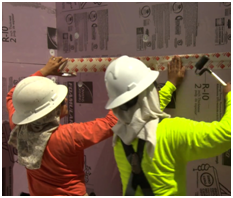
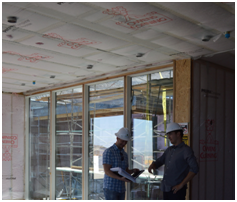
3. A Spirit of Collaboration
Armed with the builder’s vision and modeling data, Owens Corning building scientists collaborated with the Element Design Build team from blueprint to completion to achieve a comfortable, high-performing home that is greater than the sum of its parts.

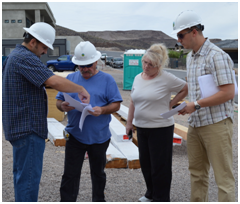
4. Comfort Delivered
Las Vegas is famous for its triple-degree temps, but frigid temperatures are also common in the winter and the desert climate means there is often a huge variance between daytime and evening temperatures. And as temperatures shift, so does the mean dew point, creating moisture management considerations. Element Design Build and Owens Corning Building Science experts created a customized, climate-specific strategy that assesses how the home performs year-round, allowing the home to balance air and moisture levels while minimizing thermal bridging in the home’s walls. The result? A home that is as comfortable in January as it is in July, March or October.
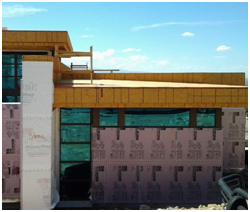
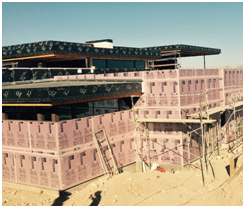
Don’t miss the finished New American Home at IBS- Visit Owens Corning Booth #P3 for all the info.
Photo Credit: Element Design Build, Video Courtesy of NAHB
The New American Home® is a registered trademark of the National Association of Home Builders.
By all accounts, 2015 is a very good year for the multifamily housing industry. Projected 2015 U.S. multifamily construction starts should top 455,000 units, or about $85.1 billion. That’s a 25 percent dollar increase over the torrid 2014 construction pace.
And 2016? Multifamily builders may throttle back a trifle, but only a trifle. The construction pace will still be frenetic. A surging rental marketplace – especially apartment-hungry Millennials (born 1982-2004) – will keep occupancy and rental rates high.
If anything, the stars have aligned like never before for multifamily builders. Mounting evidence reveals:
For the multifamily construction trade, the news could hardly be better. As Tim Sullivan, practice leader for Meyers Research LLC says, “Multifamily left single-family in the dust five years ago.” Another industry watcher seconds Sullivan’s stark conclusion. “Younger people, especially Millennials, are waiting longer to get married. We have renters who are staying renters,” reports Greg Willett, vice president of MPF Research.
The Harvard Joint Center for Housing Studies released a report last June that declares this decade will be “the strongest decade for renter growth in history.” The growing conclusion for local, regional, and, yes, national home builders? Follow the dollars. Some production home builders have already placed big bets:
As one regional home builder expanding their business into apartment construction puts it, “We are actually providers of shelter. Apartments are a large component of shelter.”
If you have all you can handle keeping up with new home orders, congrats and keep it up. If you’re looking to diversify your portfolio of construction services, as many home builders are, now is a great time to explore your multifamily options.